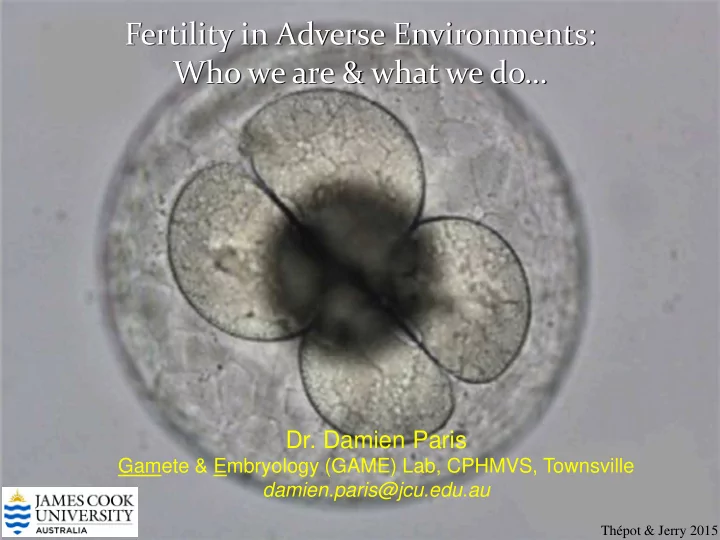

Fertility in Adverse Environments: Who we are & what we do… Dr. Damien Paris Gamete & Embryology (GAME) Lab, CPHMVS, Townsville damien.paris@jcu.edu.au Thépot & Jerry 2015
Research Interests: Assisted reproduction in wildlife ( marsupials, African wild dogs & barramundi ) Impact of adverse conditions ( IVF, heat-stress, social-stress, disease & maternal- age ) on fertility ( various animal models ) Techniques used: highly sensitive molecular tools as ‘ barometer ’ to detect compromised viability in sperm & embryos: o CASA, TUNEL, immunofluorescent microscopy, qRT-PCR, semen collection, sperm cryopreservation, artificial insemination & IVF I don’t feel so good!
S Peña (PhD): Impact of heat-stress on sperm DNA integrity & mitigation by antioxidants in the boar a b b Sperm DNA damage: up to 16-fold higher in peak wet Antioxidant Treatment: significantly decreases sperm DNA damage after 42 & 84 days
F Van den Berghe (PhD): Developing artificial insemination & influence of appeasing pheromones on stress & aggression in endangered African wild dogs DAP Treatment: - signif decline in testosterone after intervention & reintroduction - shift from contact to non-contact dominant behaviour
A Marc (PhD): Developing advanced reproductive techniques to detect infertility & accelerate selective breeding in barramundi P Frias-Alvarez (Postdoc): Impact of chytrid fungus on sperm quality in the endangered Corroboree frog
Sperm quality analysis tools: CASA, TUNEL/FACS, fluorescent microscopy Assisted reproductive techniques: semen collection, sperm freezing, artificial insemination, IVF Embryo viability & paternity testing: DAPI, morphology, protein & gene expression, microsatellite analysis Mitigation strategies: nutrient, pheromone & behaviour Damien Paris Dean Jerry Bruce Gummow Anthony Parker Monique Paris damien.paris@jcu.edu.au
Recommend
More recommend